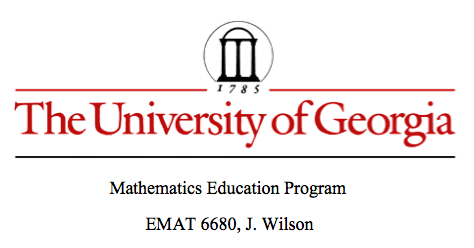

From Fibonacci to Lucas and Beyond
by
Patty Wagner
 In this investigation, I am using an Excel Spreadsheet to investigate the Fibonacci Sequence. Running along the left hand side of this page are the first 186 terms of the Fibonacci Sequence. We can see an interesting pattern when we look at the ratio of consecutive Fibonacci numbers.
In this investigation, I am using an Excel Spreadsheet to investigate the Fibonacci Sequence. Running along the left hand side of this page are the first 186 terms of the Fibonacci Sequence. We can see an interesting pattern when we look at the ratio of consecutive Fibonacci numbers.

The column to the right shows the values of these consecutive ratios. We can see that they oscillate back and forth like a weight on a spring and seem to "come to rest" at a particular value; at what appears to be 1.618033989 on this chart. Mathematicians call this value the "Golden Ratio," and although in this column of numbers it appears that the value is reached fairly quickly, in actuality the values continue to oscillate an amount that is seen further and further beyond the decimal place. It actually takes an infinite number of Fibonacci terms to finally produce the golden ratio!
Here is a chart that demonstrates visually the oscillation towards the Golden Ratio:

The Golden Ratio is important because it is often seen in nature and is considered aesthetically pleasing. For example, look at the rectangles below and consider which is the most appealing:




If you chose the one on the right, you are like most people. The ratio of the length to the width of that rectangle is 1.618033989... to 1, the Golden Ratio*.
One of the most interesting mathematical properties of the Golden Ratio is that the inverse of the Golden Ratio is equal to its decimal. In other words, the Golden Ratio equals 1.618033989... and the inverse equals 0.618033989...!
When I look at the ratio of every second term and the ratio of every third term of the Fibonacci Sequence, I see the pattern of convergence to a number continues; but each value is different. Is there some relation between them? When I plot these values as a function of the number of terms of separation, I see the values increase exponentially. This reflects the exponential nature of the Fibonacci Sequence.
 Interestingly, each successive ratio converges to a number that is greater than the previous by the amount of the ratio previous. In other words,
Interestingly, each successive ratio converges to a number that is greater than the previous by the amount of the ratio previous. In other words,
R(n) = R(n-1) + R(n-2)
which, of course, reflects the pattern of the Fibonacci Sequence.
However, even more interesting is the following. Say that the Golden Ratio equals ᵩ, then
Next, I tried the Lucas Sequence, which follows the same pattern as the Fibonacci Sequence except that the first two terms are 1 and 3. This again produces an exponential growth of numbers; but most astonishing is that the ratio converges again to the Golden Ratio!
This made me wonder if I might get the Golden Ratio regardless of the beginning terms. Using www.random.org, I generated random numbers between -50 and 50 for the first two terms.


Each time the ratio of consecutive terms converged to the Golden Ratio. The Golden Ratio, Fibonacci, Lucas and similar sequences are truly remarkable!
*Thanks go to Mr. Narain's Golden Ratio Page for rectangle images.